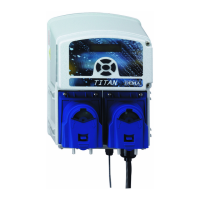
Do you have a question about the DEMA TITAN II T-812-LL and is the answer not in the manual?
| Brand | DEMA |
|---|---|
| Model | TITAN II T-812-LL |
| Category | Control Unit |
| Language | English |
Ensure installation meets national and local electrical codes, consult certified electrician if needed.
Always turn off all electrical power to the dispenser and machine before installation.
Adhere to local plumbing codes and use approved backflow prevention devices for installations.
Wear appropriate protective clothing and eyewear when working with chemical products.
Assess dish room for optimal Titan placement and plan electrical connections.
Securely mount the dispenser bracket on the wall away from steam and splashing.
Connect power, ground the unit, and install probes and injection fittings as required.
Measure and cut tubing for chemical containers and injection points, ensuring correct lengths.
Connect wiring between the Titan dispenser and the dish machine for proper operation.
Procedure to reset forgotten access codes by manipulating specific board solder points.
Utilize 24VDC output terminals for connecting external alarm devices like buzzers or relays.
Access and adjust initial dispenser configuration settings for optimal performance.
Modify set points and feed rates for concentration mode operations.
Configure settings specific to the probeless operation mode and its triggers.
Adjust rinse speed, delay, and maximum run time for effective rinsing.
Configure sanitizer speed and operating mode (run with rinse or detergent).
Enter diagnostic mode to test functions without triggering alarms.
Save all programmed changes and exit the programming menu.
Use inductive probe for scale-prone tanks; features temperature adjustment for soap levels.
Employ magnetic sensors for trigger detection when direct wiring is not feasible.
Non-contact sensors detect low chemical levels, requiring no programming or calibration.
Automatic switching between Concentration and Probeless modes due to probe faults or readings.
Resolve no-power symptoms by checking wiring, connections, and unit switches.
Address pump priming problems by inspecting tubing, squeeze tubes, and fittings for leaks.
Troubleshoot overfeeding by checking feed rate settings and probe connectivity or cleanliness.
Troubleshoot underfeeding by checking probe cable shorts, probe scale, or set point range.
Fix rinse/sanitizer pump non-operation by verifying speed settings and proper operation.
